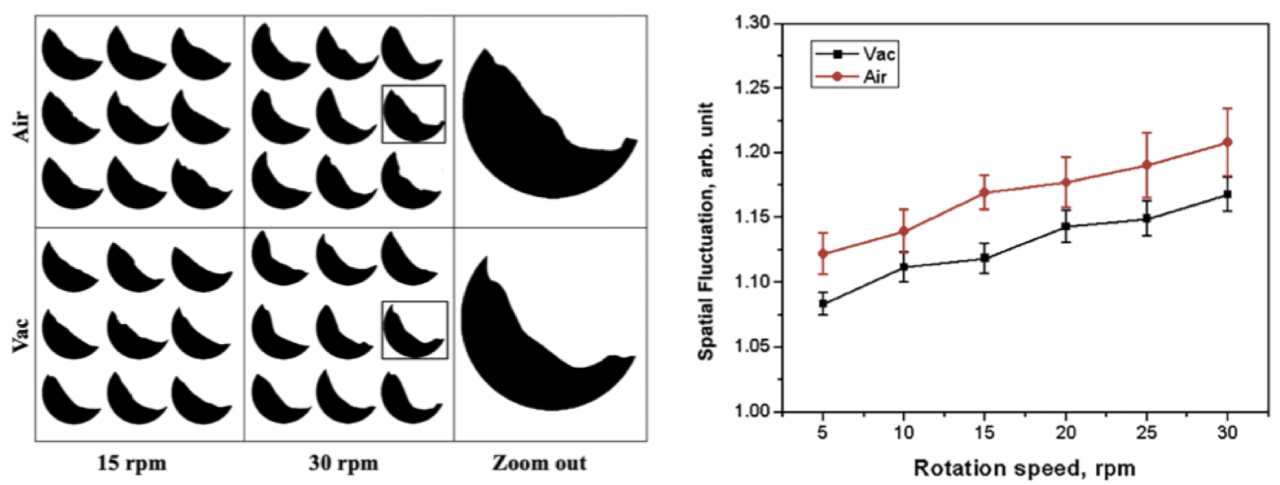Blog
The birth of a new parameter measured by the GranuDrum: the Roughness index 𝑅𝐼
Learn more about the development of a new physical parameter for the GranuDrum instrument with our new blog article.
Introduction
This blog article shows how academic researchers developed a new physical parameter for the GranuDrum instrument. This parameter called Roughness index RI is now included in GranuDrum software and quantify the powder/air interface spatial irregularity. This success story shows how the versatile GranuDrum instrument can be used to perform customized and original measurements, and how we improve our software at GranuTools in close collaboration with industrialists and academics.
LEARN MORE ABOUT THE GRANUDRUM
The GranuDrum
The GranuDrum is a versatile powder flow analyzer based on the well know rotating drum geometry. The powder flow is recorded by a camera and the images are analyzed. One can define an infinity of methods to analyze these images. Moreover, the images can be recorded in many conditions, mainly defined by the rotating speed sequence. GranuTools proposes well defined methods and protocols giving a set of coherent physical parameters well related to applications [1]. For example, it has been proven that the cohesive index CI quantifying the powder flow fluctuations is related to irregularities in powder bed-based 3D printing methods [2]. The cohesive index variation with the rotating speed characterizing the powder rheology (shear-thinning or shear-thickening) is useful to improve die filling in pharmaceutical industries [3]. Many other examples linking GranuDrum measurements and industrial processes can be found in the set of GranuTools publications and application notes. Sometimes, an application needs a very particular analysis or academic researchers want to develop new methods. GranuDrum software allows that by exporting the raw data. The images sequences are accessible but also the coordinates of the powder/air interface for the whole set of images. After exportation, the user can run in-house analysis methods with Excel, MatLab, Python scripts, C/C++ codes, …
Powder bed fusion, the most popular technique in metal additive manufacturing, utilises mainly two energy sources to melt the powder: laser or electron beam. Electron beam melting (EBM) process is operated in vacuum and the powder flowability is a major concern as it affects the final product quality. Unfortunately, till recently, measuring powder flow behaviour at low atmospheric pressure was extremely unusual.
In 2020, the team of Prof. Mathieu Brochu from McGill University published a paper [4] showing how to use the GranuDrum to characterise powder flow in controlled and low-pressure environments. As shown by Figure 1, a customized measurement cell has been designed and built by the team. Moreover, the images have been analysed with an in-house method to measure the spatial fluctuation of the interface. This spatial fluctuation (that will become the Roughness index RI of GranuTools) was defined as the ratio of the length of the powder when it is in motion, Dm, to the length of the stationary powder inside the drum, Ds. As shown by Figure 2, this parameter can differentiate a powder flowing in the air and in low pressure conditions.
LEARN MORE ABOUT THE GRANUDRUM

Figure 1: (Bottom-left) Regular and customized low pressure GranuDrum measurement cell developed by the academic researchers. (Center-top) Micrographs of the considered titanium alloy powder Ti-6Al-4V. This powder is commonly used for Laser Powder Bed Fusion (LPDF) applications. (Bottom-right) Two pictures showing the analysis method. Figure adapted from [4].
GranuTools took inspiration from the work of Brochu et al. to define the new parameter Roughness index RI and recently published a paper in the review measurement [1] to present it. This interesting parameter has also been implemented in GranuDrum software.

Figure 2: (Left) Pictures of the powder flowing in the drum in atmospheric and low-pressure conditions. (Right) Spatial Fluctuation measured in both conditions. Figure adapted from [4].
This success story shows how the GranuDrum can be used to perform customized and original measurements, and how we improve our software at GranuTools in close collaboration with industrialists and academics.
LEARN MORE ABOUT THE GRANUDRUM
References
[1] Measuring powder flow properties in a rotating drum, A. Neveu, F. Francqui, and G. Lumay, Measurement 200, 111548 (2022)
[2] Rheological behavior of β-Ti and NiTi powders produced by atomization for SLM production of open porous orthopedic implants, G. Yablokova, M. Speirs, J. Van Humbeeck, J.-P. Kruth, J. Schrooten, R. Cloots, F. Boschini, G. Lumay, J. Luyten, Powder Technology 283, 199–209 (2015).
[3] Impact of Powder Properties on the Rheological Behavior of Excipients, P. H. Janssen, S. Depaifve, A. Neveu, F. Francqui, and B.H. Dickhoff,. Pharmaceutics 13(8), 1198 (2021).
[4] Investigation of the rotating drum technique to characterise powder flow in controlled and low pressure environments, E.R.L. Espiritu and A. Kumar and A. Nommeots-Nomm and J.A.Muniz Lerma and M. Brochu, Powder Technology 366, 925 (2020).
DISCOVER OUR APPLICATION NOTES
Do you have questions about powder characterization ?
